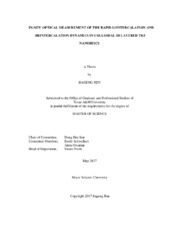| dc.description.abstract | Due to weak interlayer interaction, layered materials have been employed to accommodate various species of guests for energy storage and properties’ modulation. Combined with riveting opto-electronic characteristics introduced by dimensions’ reducing, two-dimension semiconducting nanomaterials including nanosheets, nanoflakes, nanoplates and nanodiscs have attracted attentions for research on optical and electronic devices, electrical cell development and so on. For these topics, many compounds from transition metal chalcogenides are candidates. TiS2 has been intensively tested for battery electrode material with acceptance of Li^+ . The dynamics and optical properties of this guest-host couple has been investigated on 2D TiS2 nanodiscs in this thesis.
First an electrochemical platform was assembled for controllable lithium intercalation and deintercalation. Those ion migration processes with the nanodiscs led to observable and reversible optical change. The optical change resulting from ion intercalation and electron reception was monitored in situ and analyzed as a beacon for ion diffusion. To perform the goals of electrochemical control and live optical measurement, the electrochemical platform was built in a cuvette. The lateral confined 2D TiS2 nanodiscs were deposited as a thin film on a transparent and conducting substrate to be intercalated with lithium from the electrolyte. Appropriate electrode voltages were applied to test the cyclic behavior of 2D TiS2 with Li^+ intercalation and deintercalation. The same voltage was applied using non-intercalant ions with a result of small portion of absorption change, which addressed that major contribution of the optical change was from ion intercalation rather than surface electron acceptance.
Upon lithium intercalation and deintercalation, visible absorption was weakened and recovered reversibly. The absorbance change fraction at the most drastic wavelength was extracted and analyzed for dynamics examination. Besides reversible optical switching in TiS2 nanodiscs film, the responding time component was extracted to be just a few seconds compared with several quarters and hours by similar thickness of MoS2 thin film in larger dimension. The absorption change fraction was tested and fit through a simplified radial diffusion model to estimate an ‘effective’ diffusion coefficient. The result shared the same order of diffusion coefficient of Li in TiS2 thin films and observation of Li in MoS2 films. | en |


